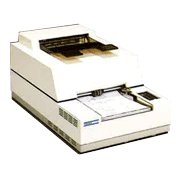The FACOM 6321A was an entry-level OCR that began shipping in 1985. The reader connected to a personal computer. The computer was used as an OCR controller by loading OCR controller software on the computer. The FACOM 6321A was designed to be compact and lightweight for easy office installations as well as to be price competitive. Its main features were as follows:
- It was desktop sized so that it could be placed in a small area on a table.
- It could recognize handwritten characters (letters, numbers, symbols, and kana characters).
- The latest ultra-LSI technology was used to make the reader compact.
- The maximum form size was limited to the highly practical A4 size to keep the reader compact and inexpensive.
- It was the first Fujitsu OCR to use a computer as its controller. RS-232C was used to connect to the scanner unit.
- To support a greater range of applications, the FACOM 6321A supported reading 7B font characters on embossed cards [Note 1].
- Taking advantage of the computer controller, a BASIC language programming environment was provided so that users could create custom data entry applications.
Fujitsu began shipping the OCIR (which stood for Optical Character and Image Reader) in 1986, which was based on the FACOM 6321A and its entry-level features. The OCIR was designed to meet the specifications of a tender by the Ministry of Labour for reception terminals for an employment information system to be installed at public employment security offices. The OCIR was the first OCR capable of full-fledged image data entry for a large-scale system deployed nationwide.
- The OCIR could read maps and other images.
- It could recognize and print barcodes that represented job applicant numbers. [Note 2]
- It was bundled with functions and applications specifically for reception operations. [Note 3]
Note 1: Embossed cards are plastic cards with embossed printing such as that used on credit cards. The 7B font was frequently used for the printing on embossed cards. Reading characters from embossed cards required character recognition processing that accounts for card-specific problems such as noise remaining from the printing process, character blurring, and the inclination of character strings.
Note 2: The OCIR was Fujitsu’s first OCR-based barcode reader. The OCIR included recognition techniques to read barcodes even when crunched or grazed.
Note 3: To improve the efficiency of the reception terminal operations, firmware and software applications were used to create functions to continuously process a mix of different form types (with different formats and lengths such as job-seeking slips and job applications) by reading IDs that identified each form type.


